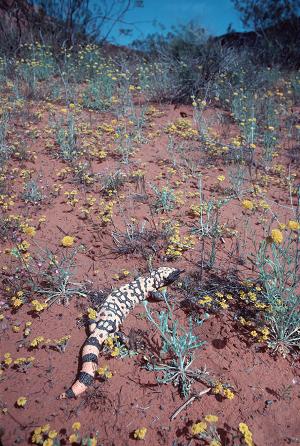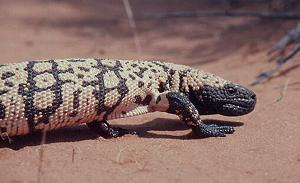
Click for larger view
Copyright Daniel D. Beck
Central Washington University
Hi, I’m Holly Strand from Stokes Nature Center in beautiful Logan Canyon.
Turn up your radio and see if you can imagine the Utah creature who makes this sound.
[Sound: Jeff Rice, Gila Monster recorded at Arizona-Sonora Desert Museum]
That was the gasping breathing of a gila monster. It was recorded by Jeff Rice of the University of Utah’s Western Soundscape Archive.
Gila Monsters occur in pockets across the desert southwest. In Utah they are found only in Mojave habitat in the southwest corner of Washington County.
Once you get to know them, gilas are not at all monstrous. They are the largest of all lizards native to the U.S. An average gila might be 14-16 in. in length and would weigh about a pound and a half. They have thick sausage-like tails and large heads. The scales on the backs of these lizards resemble a beadwork pattern of black, orange, pink, and yellow.
Of the nearly4000 lizard species in the entire world only two are venomous. And one of them is the gila monster. But only a small amount of venom is introduced during a bite—not enough to kill a healthy human. Nevertheless, the bites are notoriously painful.

Click map for larger view
Copyright Daniel D. Beck
Central Washington University
But gilas are reluctant to strike. Victims of bites have usually provoked the lizard in some way. Before biting, the lizard will hiss, and then back away from its would-be attacker. But if these warning efforts fail, it will latch on with frightening speed and tenacity. For gilas are the pitbulls of the lizard world.
A long-held belief has been that the breath of a gila monster is nauseating and toxic. In fact, it was even thought that gilas killed their prey with halitosis. The truth is that like many other animals, a frightened gila may regurgitate a recent meal when molested. Because gilas have such a slow metabolism, that last meal might be pretty old and smelly. Also, excited or reproductively active monsters can transmit a detectable body odor which some people find offensive.
These days, you’d be very lucky to see a gila monster in the wild. For in many areas their numbers are decreasing though collection and habitat loss. Another reason is that gila monsters are homebodies. They spend up to 97% of their lifetime tucked away in burrows or rock crevices.
For sources and pictures of gila monsters, see www.wildaboututah.org.
Thanks to the Rocky Mountain Power Foundation for support of this Wild About Utah topic.
For Wild About Utah and Stokes Nature Center, I’m Holly Strand.
Credits:
Images: Courtesy & Copyright Daniel D. Beck, Central Washington University
Text: Holly Strand, Stokes Nature Center
Sources & Additional Reading
Beck, Daniel D. 2005. Biology of Gila monsters and beaded lizards
Beck, Daniel D.,1990. Ecology and behavior of the Gila Monster in southwestern Utah. Journal of Herpetology 24, pp. 54–68.
Brown, David. E. Carmony, Neil. B. 1999. Gila Monster : Facts and Folklore of America’s Aztec Lizard. Salt Lake City: University of Utah Press. https://www.amazon.com/Gila-Monster-Folklore-Americas-Lizard/dp/0874806003
Rice. Jeff. Western Soundscape Archive. J. Willard Marriott Library at the University of Utah, https://westernsoundscape.org/
State of Utah Natural Resources. Division of Wildlife Resources Species Database. Gila Monster. https://dwrcdc.nr.utah.gov/rsgis2/Search/Map.asp?Id=691 [Accessed Feb 2, 2010]
For More Information:
National Geographic . Wild Detectives: Gila Monster https://www.youtube.com/watch?v=59LRezTYkeo [Accessed Feb 2, 2010]
Arizona-Sonora Desert Museum https://www.desertmuseum.org/books/nhsd_gila.php [Accessed Feb 2, 2010]
